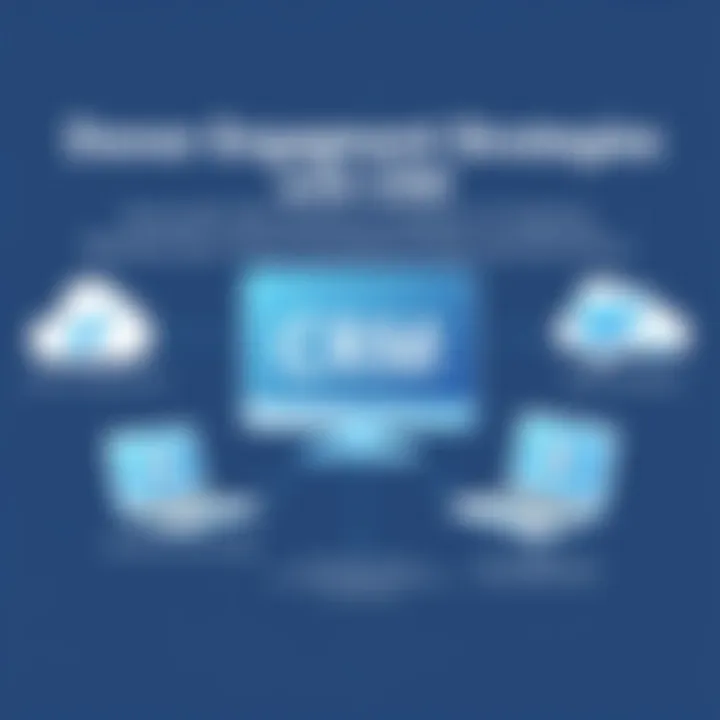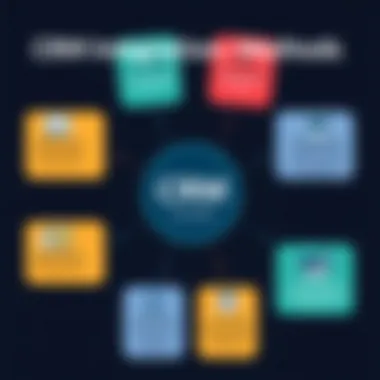Nonprofit CRM Solutions: Enhancing Relationships and Efficiency


Intro
In today's dynamic landscape, nonprofit organizations find themselves navigating challenges that demand innovative solutions. The pursuit of building enduring relationships with donors is more crucial than ever. Enter Customer Relationship Management (CRM) systems specifically designed for nonprofits.
These tools promise not only to streamline operations but also to enhance the connections that define an organization’s success. The journey to finding the right CRM solution can be a daunting one, filled with questions about features, pricing, and implementation strategies. This article serves as a guiding light, providing insights into the world of nonprofit CRM solutions.
Through careful exploration, we will examine key features and functionalities that these systems offer – from donor management to reporting capabilities. We’ll break down pricing models and additional costs that can sneak up on decision-makers. Finally, we look ahead at potential pitfalls nonprofits may encounter during adoption and integration processes. With these insights, you'll be better equipped to make informed decisions that boost your organization’s effectiveness and impact.
Let’s embark on this comprehensive exploration together.
Understanding Nonprofit CRM
In the ever-evolving landscape of nonprofit organizations, the effective management of relationships with supporters, volunteers, and beneficiaries is crucial. This is where Customer Relationship Management (CRM) systems come into play. Nonprofit CRM is tailored to suit the unique needs of charitable organizations, focusing on donor management, engagement strategies, and operational efficiency. Embracing a well-suited CRM can dramatically enhance how nonprofits operate, enabling them to foster stronger relationships and achieve their missions more effectively.
Definition of Nonprofit CRM
Nonprofit CRM refers to specialized software designed to help nonprofit organizations manage their interactions with constituents, be it donors, volunteers, or beneficiaries. Unlike traditional CRM systems, which often cater to for-profit entities, nonprofit CRMs incorporate features and tools that cater to the distinct challenges and requirements faced by nonprofits. These may include donor tracking, event planning, and communication tools that align with fundraising goals and community engagement initiatives.
By centralizing data about supporters, contributions, and outreach efforts, nonprofit CRMs enable nonprofits to streamline processes and create informed strategies.
Importance of CRM in Nonprofit Sectors
CRM systems play a pivotal role in enhancing operational efficiency within nonprofit sectors. The importance of these tools can be broken down into several key areas:
- Improved Donor Relations: A robust CRM system allows organizations to tailor communications and engagement strategies, fostering deeper connections with donors. By analyzing past interactions, nonprofits can predict future giving behaviors and adapt accordingly.
- Streamlined Operations: Nonprofits often wear many hats. With a dedicated CRM, organizations can automate time-consuming tasks such as data entry and follow-ups. This means staff and volunteers can focus on mission-critical activities rather than getting bogged down in administrative work.
- Data-Driven Insights: The ability to collect and analyze data enables nonprofits to make informed decisions based on trends and patterns. Understanding donor behavior can lead to strategic approaches, ensuring funding and support continues to grow over time.
Difference Between Nonprofit and Traditional CRM
While both nonprofit and traditional CRM systems share common functionalities, their core differences lie in their objectives and feature sets. Here’s how they stack up:
- Target Audience:
- Features:
- Pricing Models:
- Community Engagement:
- Nonprofit CRMs cater specifically to fundraising, donor management, and volunteer engagement, while traditional CRMs target customer management in commercial industries.
- Nonprofit-focused CRMs include features such as donation tracking, grant management, and event planning. In contrast, traditional CRMs often emphasize sales forecasting and lead management.
- Many nonprofit CRM solutions offer special pricing or tiers for charities, recognizing the financial constraints nonprofits often face. Traditional CRMs may not follow the same flexibility in pricing.
- Nonprofit CRMs prioritize community engagement, incorporating tools for campaign management and outreach, whereas traditional CRMs focus on enhancing the buyer-seller relationship.
Understanding these differences is essential for nonprofits to select the right tools that will support their unique goals. A comprehensive grasp of what nonprofit CRM entails and its benefits sets the stage for making informed decisions about implementing these systems, ensuring alignment with organizational objectives.
Key Features of Nonprofit CRM
When selecting a Customer Relationship Management (CRM) system for a nonprofit organization, understanding the key features that differentiate it from traditional CRM tools is essential. The main aim here is to not just manage data but to foster stronger relationships with donors, volunteers, and communities. This section delves into the critical features offered by nonprofit CRM solutions that enhance operational efficiency and strategic donor engagement.
Donor Management
Donor management is the cornerstone of any nonprofit CRM. This feature facilitates the organization of donor data into a coherent structure. Nonprofits often rely on different sources of funding ranging from individuals to corporate sponsors. A robust donor management system allows organizations to track donor interactions, segment the donor base, and manage relationships effectively. With effective donor management, nonprofits can identify top contributors, engage with them meaningfully, and tailor communication to foster long-term relationships.
Moreover, it’s crucial for nonprofits to keep the communication lines open. Using donor management features, users can send personalized thank-you notes or updates on how donations are used, ensuring that donors feel valued and recognized. Organizations who neglect this aspect could easily find themselves losing touch with their lifelines.


Contribution Tracking
Contribution tracking goes hand-in-hand with donor management; it’s about maintaining a meticulous record of all financial donations received by the organization. Effective contribution tracking allows nonprofits to see a detailed history of donations, including amounts, channels of contributions, and the impact reports for donors. This promotes accountability and transparency—qualities that donors often prioritize before contributing.
A well-structured system will categorize contributions by campaigns or events, helping organizations assess what resonates with their audiences. For instance, if one particular fundraising event raises significantly more than others, nonprofits can analyze what strategies worked and replicate them in the future.
Event Management
Nonprofits frequently host events to raise funds and build community engagement. Thus, an event management feature within a CRM is vital. This function can help manage event details, from planning logistics to tracking registration and ticket sales. For example, a charity gala might require detailed planning around venue selection, catering, and guest lists. An effective CRM simplifies these tasks tremendously.
Additionally, event management features can provide metrics post-event. Post-event analytics can gauge attendance, contributions, and engagement levels. Insights gained can guide future events and help in tailoring experiences for donors and participants alike.
Reporting and Analytics
In today’s data-driven environment, data analysis capabilities in a nonprofit CRM is non-negotiable. Reporting and analytics functionalities allow organizations to generate insightful reports about donor behaviors, fundraising effectiveness, and overall operational efficiency. With these insights, organizations can make informed decisions and adapt strategies that align with their missions.
For instance, if a report shows declining donor retention rates, an organization can dive deeper into the data to identify patterns or issues causing this trend. It helps put numbers behind emotions, transforming them into actionable insights.
Communication Tools
At the heart of effective nonprofit operations is robust communication. A nonprofit CRM typically includes features that facilitate seamless communication between the organization and all stakeholders. Tools like email marketing integration, social media connectivity, and automated communication workflows come in handy.
Imagine an organization running a campaign. They can easily create tailored messages and send them directly to specific donor segments. This personalization goes a long way in keeping donors engaged and informed about the organization’s work. Furthermore, automation ensures that no one falls through the cracks, as reminders can be set for follow-ups, renewal notices, or thank you messages.
Effective communication is the grease that keeps the wheels of a nonprofit organization turning smoothly.
Evaluating Nonprofit CRM Solutions
Choosing the right CRM solution isn't just a matter of convenience; it can define how effectively a nonprofit engages with its community, manages operations, and ultimately, fulfills its mission. Evaluating these solutions involves understanding the unique needs of a nonprofit organization and identifying CRM features that can help meet those challenges. An effective CRM can streamline communication, enhance donor relations, and provide valuable insights into fundraising efforts. Thus, it’s crucial to approach this evaluation with a careful eye on what each option offers and how it aligns with the organization’s goals.
Criteria for Selecting a Nonprofit CRM
When it comes to selecting a nonprofit CRM, several criteria should be taken into consideration to ensure that the right choice is made:
- User-Friendliness: The system should be easy to navigate, enabling staff and volunteers to utilize it effectively without extensive training.
- Customization Options: Nonprofits often have unique operational structures. Hence, a CRM that allows customization to meet specific requirements can be a game changer.
- Integration Capabilities: A good CRM must integrate well with other systems already in use, such as accounting software or email marketing tools.
- Scalability: As nonprofits grow, their needs may change. The chosen CRM must be capable of adapting to increased data and more complex processes.
- Cost-Effectiveness: Nonprofits operate under budget constraints. Therefore, it’s vital to look for solutions that offer essential features without breaking the bank.
Being mindful of these elements can ultimately lead to improved operational efficiency and greater engagement with supporters.
Popular Nonprofit CRM Tools
Several CRM tools are popular among nonprofits for their tailored features and functionality. Here’s a closer look at a few noteworthy options:
Salesforce for Nonprofits
Salesforce for Nonprofits stands out for its comprehensive suite of tools that promote donor management and engagement. One of its key characteristics is its robust customization, allowing organizations to adapt the software to their specific workflows. Its powerful reporting features are another compelling aspect, enabling nonprofits to glean insights from their data effectively. However, some may find its steep learning curve a bit challenging when first starting out, which could pose issues for smaller organizations with limited tech expertise.
Blackbaud
Blackbaud offers a suite of software specifically designed for the needs of nonprofits, focusing on fundraising, donor management, and financial management. Its cloud-based platform provides accessibility for teams working remotely, a significant boon in today’s digital age. The platform is particularly appealing due to its integrated fund accounting features, which streamline financial management. Nevertheless, some users have noted that the cost can be higher than competitors, making it a consideration for budget-conscious nonprofits.
Bloomerang


Bloomerang is tailored for small to mid-sized nonprofits and is known for its ability to focus on donor retention and engagement. The intuitive interface makes it easy for users to manage their relationships and track donor history. A unique feature is the donor retention metric, which allows organizations to assess the effectiveness of their engagement efforts. However, it may lack some advanced features that larger organizations might require, which could limit its use in those contexts.
HubSpot Nonprofit CRM
HubSpot Nonprofit CRM is appreciated for its free tier, making it accessible for nonprofits just starting out. Its marketing automation features help organizations reach wider audiences effectively. Furthermore, the user-friendly design is beneficial for teams with varying levels of tech savviness. On the flip side, as a nonprofit grows and its needs become more complex, it may require advanced features that are not available in the free version, necessitating an upgrade.
Cost Considerations
Cost considerations play a fundamental role in the decision-making process regarding CRM software. Nonprofits must balance the necessity of specific features with budgetary constraints to ensure they get value for their investment. It is important to look not only at the upfront costs but also at ongoing expenses like support, upgrades, and maintenance. From subscription fees to hidden costs, understanding the total cost of ownership can help organizations avoid unexpected financial strains. Moreover, many CRM providers offer discounted pricing or special features for nonprofits, making it essential to inquire about these benefits during the evaluation process.
In summary, a thoughtful evaluation of nonprofit CRM solutions encompasses assessing diverse criteria, understanding popular options available, and taking the cost into account. Each nonprofit’s needs are unique, and investing time in this evaluation will pay dividends in heightened engagement and operational efficiency down the road.
Implementing Nonprofit CRM
Implementing a Customer Relationship Management (CRM) system within a nonprofit organization is not merely a technical undertaking; it’s a transformative endeavor that can redefine the way an organization engages with donors, operates internally, and enacts its mission. A well-planned implementation ensures that technology aligns seamlessly with organizational goals, enhancing efficiency and fostering deeper relationships with stakeholders. Let’s delve deeper into some of the pivotal aspects of this process, from planning to integration.
Planning the Implementation Process
Before diving headfirst into implementation, one must adopt a well-thought-out approach. This planning stage is crucial as it lays the groundwork for a successful transition. Here are some key considerations:
- Assess Needs: Begin by identifying specific needs within the organization. This involves consulting with stakeholders, such as fundraisers, program managers, and volunteers, to know what features would best serve them.
- Define Goals: Setting clear, measurable goals is essential. Whether it’s improving donor communication, increasing engagement, or automating reporting, having defined objectives provides direction.
- Create a Timeline: Implementation isn't an overnight task. Establish a realistic timeline that considers phases such as data migration, staff training, and testing.
- Budgeting: Financial constraints are often at the forefront of nonprofit operations. Outline a budget that accommodates all necessary costs, including software purchase, training, and ongoing maintenance.
In sum, success hinges on aligning the implementation plan with both immediate needs and long-term goals. Getting this right can pave the way for smoother adoption down the line.
Training Staff and Volunteers
One of the most critical facets of CRM implementation is training. After all, even the best software can underperform if staff members aren’t equipped to use it effectively. Training should involve:
- Tailored Programs: Different staff roles will likely require varied training. Organizing role-specific sessions ensures that everyone knows how to utilize the CRM in alignment with their responsibilities.
- Hands-on Training: Letting staff use the system while learning allows for practical understanding. This way, learners gain comfort and familiarity, reducing future hiccups.
- Ongoing Support: After initial training, keep the momentum alive with continual support and refresher courses. As staff become more adept, they will uncover new ways to maximize the system's capabilities.
Educating your team isn't just about software; it's about cultivating a culture that embraces data-driven insights and donor-focused engagement.
Integrating with Existing Systems
In many cases, nonprofits already utilize multiple systems for various functions—be it accounting software, email marketing tools, or grant management platforms. Therefore, a key step in effective CRM implementation is ensuring that the new system integrates smoothly with what’s already in place. Here are important elements to consider:
- Data Migration: Transitional processes should emphasize transferring essential data accurately without loss. This could involve data cleaning to ensure only relevant information is carried over.
- API Capabilities: Having a CRM with robust API capabilities allows it to communicate with other systems efficiently. This connectivity helps create a comprehensive tech ecosystem that enhances productivity.
- User Experience: Integration should not create confusion. Streamline user experience by ensuring that new and existing technologies work in harmony, allowing staff to operate without facing a steep learning curve.
Ultimately, successful integration of a nonprofit CRM with existing systems can enhance operational efficacy by reducing redundancy and ensuring that all tools work in concert toward a unified objective.
For organizations to truly benefit from CRM systems, the emphasis must be placed on holistic integration and shared goals rather than seeing technology as a mere addition to the existing framework.
Overcoming Challenges in CRM Adoption
When nonprofits consider adopting a Customer Relationship Management (CRM) system, they often face a myriad of challenges. Understanding these hurdles is crucial, as they can significantly impact the overall success and efficiency of the organization. Nonprofits operate under unique constraints, which can complicate the transition to a CRM system. Addressing these challenges not only helps in smoother implementation but also enhances organizational efficiency and donor engagement.
Common Barriers to Adoption
Several barriers can impede the successful adoption of CRM systems within nonprofit organizations. These include:
- Limited Budget: Nonprofits often operate on tight budgets. The initial costs of purchasing a CRM system, not to mention the ongoing expenses associated with licensing, training, and maintenance, can be daunting.
- Staff Resistance: Change doesn’t come easy, and staff members may resist adopting new technology. This is especially true in organizations where employees have grown accustomed to certain practices and systems.
- Data Migration Challenges: Nonprofits may have legacy systems in place, making it difficult to consolidate historical data into a new CRM. This migration can be fraught with data integrity issues.
- Lack of Technical Expertise: Not all nonprofits have in-house IT skills. This lack of expertise can hinder the configuration and management of the new CRM system.
- Unclear Goals: Without a clear purpose and objectives for adopting a CRM, organizations might struggle to derive meaningful usage from the software.


Effective planning and anticipating these barriers can greatly enhance the likelihood of a successful CRM implementation.
Strategies for Successful Adoption
To navigate the complexities of CRM adoption, nonprofits can employ several strategies. Here are some approaches that can lead to a smoother transition and ongoing success:
- Conduct a Needs Assessment: Before jumping in, assess your organization’s specific needs and challenges. Understanding what you require from a CRM can guide your selection process, ensuring you choose a tool that aligns with your objectives.
- Develop a Budget with Flexibility: While working within financial constraints is important, create a budget that factors in unexpected costs. This includes potential training sessions or additional tech support that may be necessary.
- Engage Staff Early: Include staff in the selection and planning process. This engagement builds buy-in and empowers them to learn the system rather than resenting its introduction.
- Invest in Training: Often, the steepest learning curve comes with not just using the software but understanding how to maximize its features. Investing in robust training ensures that staff feel comfortable and skilled in using the CRM.
- Set Clear Implementation Goals: Define what success looks like for the CRM adoption. Clear goals help keep everyone focused and motivated, making it easier to track progress and adapt as necessary.
In summary, overcoming challenges in CRM adoption for nonprofits is an essential focus point that impacts the organization’s overall effectiveness and future growth. Understanding the barriers and employing strategic, well-thought-out solutions can pave the way for successful integration of CRM systems, ultimately benefiting donor relations and operational efficiency.
Future Trends in Nonprofit CRM
The landscape of nonprofit Customer Relationship Management (CRM) is ever-evolving. Organizations need to stay ahead of the curve, or they risk falling behind in a world where engagement and efficiency are paramount. The future of nonprofit CRM is painted with trends that promise to enhance operations, improve donor engagement, and ultimately foster growth. This section will explore significant trends such as the rising importance of data analytics, the escalating demand for mobile access, and the potential for integrating artificial intelligence. Each of these elements offers unique benefits and considerations for decision-makers navigating this space.
Growing Importance of Data Analytics
Data analytics is becoming more than just a buzzword; it’s a game changer for nonprofits. With the huge amounts of data generated from donor interactions and campaigns, analyzing this information provides critical insights. Nonprofits can learn about donor preferences, track engagement trends, and measure campaign effectiveness more accurately than ever before.
- Enhanced donor segmentation allows organizations to tailor their communications and outreach efforts more effectively. For instance, if a nonprofit knows that a donor frequently supports environmental initiatives, they can prioritize related updates and campaigns.
- Predictive analytics will be a powerful tool. By analyzing past donor behavior, nonprofits can identify patterns that help in forecasting future donations. This can lead to proactive engagement strategies that can boost donor retention.
This increasing reliance on data analysis isn't just a trend; it’s a necessity for nonprofits aiming to optimize their operations and enhance their impact.
Increasing Demand for Mobile Access
In our increasingly mobile world, having the capability to access CRM systems through smartphones and tablets is essential for nonprofits. This trend is driven by several factors:
- Accessibility: Staff and volunteers can input data and update records on the go, making it easier to interact with donors and manage events in real-time, even if they are not at a desk.
- Engagement: Mobile access facilitates quick communication with donors, whether through push notifications, emails, or social media updates. This means that donors can remain informed and engaged more effortlessly.
- On-the-ground Support: For organizations conducting fieldwork, mobile access allows for immediate reporting on situations and needs, enabling swift action and support.
Providing mobile solutions for CRM systems can be a key factor in attracting younger donors as well, who favor technology and expect responsiveness.
Potential for Artificial Intelligence Integration
Artificial Intelligence (AI) has immense potential to transform nonprofit CRM systems. As organizations embrace AI, they can expect several transformative benefits:
- Personalization: AI can analyze donor data and automate personalized engagement strategies. A system that learns from interactions can suggest the best communication methods and times to reach donors, making the relationship feel more tailored and individual.
- Efficient Data Management: Automating mundane tasks such as data entry, follow-up emails, and engagement tracking can save substantial time for staff. AI tools can sort through large data sets to highlight priority contacts or trigger automated responses based on donor behavior.
- Campaign Effectiveness: AI can simulate countless campaign scenarios, analyzing which strategies have the highest returns. This adaptive technique enables nonprofits to pivot strategies based on real-time data without extensive trial and error.
While the integration of AI is still at an early stage in the nonprofit sector, its promise is undeniable. Embracing these advancements will empower organizations to focus more on their core missions rather than administrative tasks.
"Staying ahead in CRM technology means not only adopting new tools but also understanding how they reshape our relationship with donors."
Finale
In wrapping up this guide, it is vital to underscore the paramount role nonprofit CRM systems play in the operational prowess of organizations in the nonprofit sector. As we’ve delved into, these systems are not mere tools; they are lifelines that help institutions navigate the complexities of donor relationships and resource management. By utilizing a comprehensive CRM solution, nonprofits can streamline their operations, build stronger connections with their supporters, and, ultimately, maintain their mission-driven momentum.
Summarizing Key Insights
To bring clarity to the discussions held throughout this article, let’s highlight some pivotal insights regarding nonprofit CRM solutions:
- Donor Engagement: Effective CRM systems facilitate improved communication, enabling organizations to engage with their donors in meaningful ways. This enhances trust and loyalty among supporters.
- Streamlined Operations: With tools designed specifically for the nonprofit landscape, manual processes are reduced, allowing staff to focus on what truly matters: their mission.
- Data-Driven Decisions: Utilizing analytics provided by CRM solutions means nonprofits can make informed decisions. Everything from donor patterns to campaign successes can and should inform future strategies.
- Cost-Effectiveness: Investing in a tailored CRM solution can lead to long-term savings. Resources can be managed more effectively, meaning that funds can be redirected to programmatic initiatives.
It’s clear that as the landscape of philanthropy continues to evolve, organizations must adapt by leveraging technology, particularly effective CRM solutions, to ensure their sustainability and growth.
Encouraging Informed Decision Making
In light of the information shared, making a choice on which nonprofit CRM solution to adopt doesn’t have to feel like shooting in the dark. Armed with knowledge of key features, evaluation criteria, and market options, decision-makers can navigate this process with greater confidence. It is essential to:
- Assess Needs Thoroughly: Understand the specific requirements of your organization, including donor volume, event needs, and reporting objectives. This clarity will serve as the foundation for your CRM selection.
- Pilot Programs: Before fully committing, consider testing a few CRM programs with limited scope. This trial phase can reveal strengths and weaknesses that a simple demo may not expose.
- Seek Feedback: Engage staff and volunteers in the evaluation process. Their input can provide invaluable insight that shapes how well the technology integrates into daily operations.
- Plan for Scalability: Choose a solution that not only addresses current needs but can grow with the organization. Flexibility in a CRM is crucial as missions evolve and expand.
As we close the chapter on this exploration of nonprofit CRM solutions, it becomes clear that these systems are more than just technology; they are enablers of strategic vision and community engagement. By taking informed steps and employing the right tools, nonprofits can enhance their impact and foster better relationships with those they serve.















